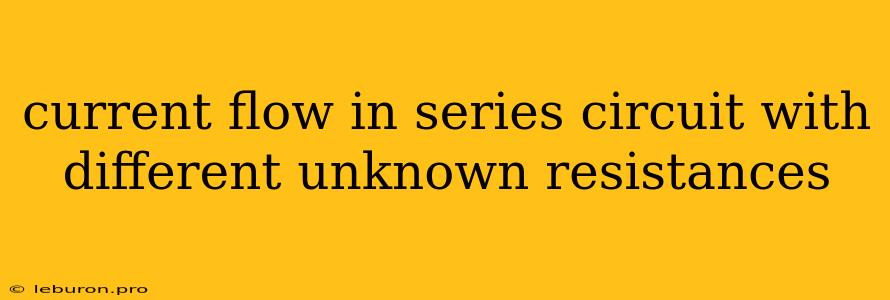Understanding how current flows in a series circuit with different unknown resistances is a fundamental concept in basic electricity. A series circuit is characterized by a single path for current flow, meaning the same current passes through each component in the circuit. This article will delve into the principles governing current flow in such circuits, exploring how to determine the current when resistances are unknown. We will examine the key concepts of Ohm's Law, Kirchhoff's Voltage Law, and the behavior of resistors in series, providing practical examples and insights to solidify your understanding.
Understanding Current Flow in a Series Circuit
In a series circuit, the current flowing through each component is identical. This is because there is only one path for the current to travel. Imagine a single lane highway with cars traveling in a line – all cars travel at the same speed. Similarly, in a series circuit, all components experience the same current flow.
Ohm's Law: The Foundation of Series Circuit Analysis
Ohm's Law is a fundamental principle that describes the relationship between voltage, current, and resistance. It states that the current flowing through a conductor is directly proportional to the voltage applied across its ends and inversely proportional to its resistance. Mathematically, this is expressed as:
I = V/R
Where:
- I is the current (measured in amperes or amps)
- V is the voltage (measured in volts)
- R is the resistance (measured in ohms)
This relationship is crucial for understanding current flow in series circuits, as it allows us to calculate the current when the voltage and total resistance are known.
The Impact of Resistance on Current Flow
In a series circuit, the total resistance is the sum of individual resistances. This is because the current must flow through each resistor sequentially, encountering resistance at each point.
R<sub>total</sub> = R<sub>1</sub> + R<sub>2</sub> + R<sub>3</sub> + ... + R<sub>n</sub>
Where:
- R<sub>total</sub> is the total resistance of the circuit
- R<sub>1</sub>, R<sub>2</sub>, R<sub>3</sub> ... R<sub>n</sub> are the resistances of individual components in the circuit.
The total resistance of a series circuit directly affects the current flowing through it. A higher total resistance leads to a lower current flow, while a lower total resistance allows for a greater current flow.
Determining Current Flow with Unknown Resistances
When faced with a series circuit where the resistances are unknown, we can still determine the current flow by applying Kirchhoff's Voltage Law and Ohm's Law.
Kirchhoff's Voltage Law (KVL) states that the sum of all voltage drops in a closed loop is equal to the applied voltage. In a series circuit, the voltage drop across each resistor is equal to the current flowing through it multiplied by the resistance:
V<sub>R1</sub> = I * R<sub>1</sub>
V<sub>R2</sub> = I * R<sub>2</sub>
V<sub>R3</sub> = I * R<sub>3</sub>
... and so on.
Applying KVL, we can write:
V<sub>total</sub> = V<sub>R1</sub> + V<sub>R2</sub> + V<sub>R3</sub> + ... + V<sub>Rn</sub>
Substituting the voltage drop expressions:
V<sub>total</sub> = I * R<sub>1</sub> + I * R<sub>2</sub> + I * R<sub>3</sub> + ... + I * R<sub>n</sub>
Factoring out the current:
V<sub>total</sub> = I * (R<sub>1</sub> + R<sub>2</sub> + R<sub>3</sub> + ... + R<sub>n</sub>)
Recognizing that the sum of individual resistances is the total resistance:
V<sub>total</sub> = I * R<sub>total</sub>
Now, to determine the current, we can rearrange the equation:
I = V<sub>total</sub> / R<sub>total</sub>
This equation allows us to calculate the current flow in a series circuit even when the individual resistances are unknown, as long as we know the total voltage and total resistance.
Practical Example: Finding Current Flow in a Series Circuit with Unknown Resistances
Let's consider a simple series circuit consisting of three resistors connected to a 12V battery. We know the total resistance is 10 ohms, but the individual resistances of each resistor are unknown.
- Apply Kirchhoff's Voltage Law: The sum of the voltage drops across each resistor must equal the total voltage (12V).
- Calculate Current: Using the equation I = V<sub>total</sub> / R<sub>total</sub>, we can find the current: I = 12V / 10 ohms = 1.2 Amps.
Therefore, even without knowing the individual resistances, we can determine that the current flowing through the circuit is 1.2 Amps.
Importance of Current Flow in Series Circuits
Understanding current flow in series circuits is crucial for various applications, including:
- Circuit Design: Knowing how current is distributed allows us to design circuits that meet specific requirements for voltage, current, and power.
- Troubleshooting: Understanding the behavior of current in a series circuit helps to identify and resolve problems within electronic systems.
- Safety: Proper understanding of current flow is essential for ensuring safe operation of electrical systems and devices.
Conclusion
Current flow in a series circuit with different unknown resistances can be determined using fundamental principles of electricity, namely Ohm's Law and Kirchhoff's Voltage Law. By applying these principles, we can calculate the current even when individual resistances are unknown. This understanding is vital for various applications in circuit design, troubleshooting, and safety. By mastering the concepts discussed, you will gain valuable insights into the behavior of series circuits and their role in various electrical systems.
